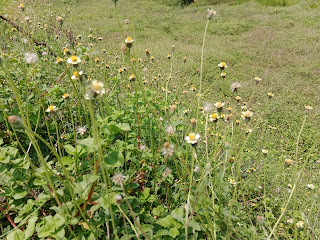Taxonomy:
- Kingdom: Plantae
- Division: Angiosperms
- Class: Eudicots
- Order: Asterales
- Family: Asteraceae
- Genus: Tridax
- Species: Tridax procumbens
Physical Characteristics:
- Tridax procumbens is a small, herbaceous annual plant that usually grows as a ground cover.
- It typically reaches a height of 15-50 cm (6-20 inches) and spreads horizontally, forming a mat-like growth.
- The leaves are simple, opposite, and lance-shaped with toothed edges. They are arranged in a rosette pattern at the base of the plant.
- The flowers are daisy-like with yellow, three-lobed petals and a central disc of tiny yellow florets. Each flower is about 1-2 cm in diameter.
- The fruit is a small, ribbed achene that contains a single seed. The seeds are dispersed by wind and water.
Habitat and Distribution:
- Tridax procumbens is native to the Americas and is found in tropical and subtropical regions.
- It is commonly found in open fields, disturbed areas, roadsides, gardens, and agricultural lands.
- Due to its hardiness and adaptability, it has become naturalized in many parts of the world and is considered an invasive weed in some regions.
Uses and Benefits:
- Despite being considered a weed, Tridax procumbens has some traditional uses in herbal medicine. It has been used in various cultures to treat ailments such as skin infections, wounds, digestive issues, and respiratory problems.
- The plant is reported to have antimicrobial, anti-inflammatory, and wound-healing properties.
- Some traditional remedies involve making poultices, infusions, or extracts from the leaves and flowers.
Ecological Impact:
- Tridax procumbens can have negative ecological impacts when it becomes invasive. It can outcompete native vegetation and disrupt natural ecosystems.
- Its ability to produce large numbers of seeds that are easily dispersed by wind contributes to its invasive potential.
Control Measures:
- Due to its weedy and invasive nature, controlling Tridax procumbens often involves using herbicides and other management strategies.
- Preventing its spread through proper land management and maintaining healthy ecosystems can help mitigate its impact.


.jpg)



